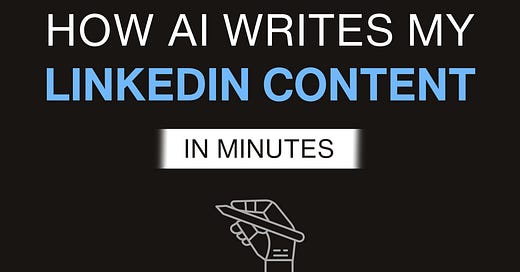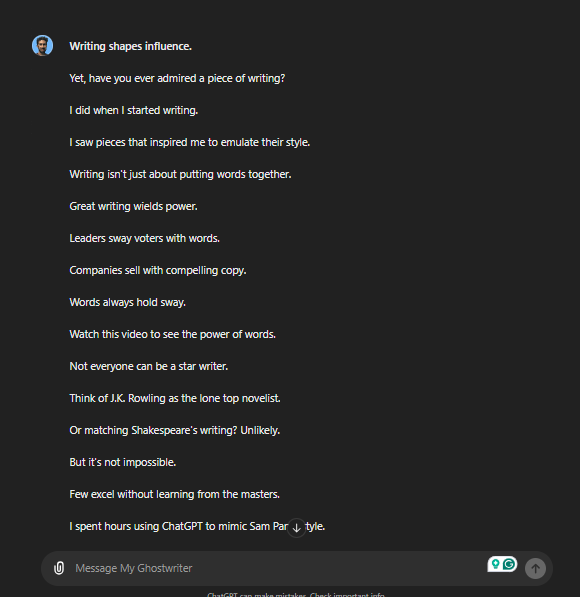Write Your First LinkedIn Post with AI in Just 3 Minutes
And put your content creation on autopilot
Hey — Sami here.
Welcome again to Savvy Snack.
Today, I have a surprise for you.
It’s something I worked hard on for a while, and am sure you'll love it.
Guess what? You’re the first to access it!
But before you see it, I want to tell you something…
Lots of people ask me how to write LinkedIn posts with AI.
That's one of the reasons I'm writing this email, too.
Writing LinkedIn posts with AI, especially ChatGPT, is much simpler and easier.
It's more about how you prompt.
Let me break it down for you:
(Don’t forget the surprise at the end!)
So… what makes a LinkedIn post good?
1: Removing passive voice
Using passive voice can confuse your reader. Also, it's harder to read passive sentences.
Most AI tools overuse the passive voice.
And that’s the reason using more passive voice seems like the it’s AI-generated.
The best thing to do is to manually change every passive sentence to an active one.
Or even better, include this line in your prompt:
"I want you to avoid using passive voice. All the sentences should be in active voice form."2: Cutting long paragraphs
We used to see long paragraphs from ChatGPT when it was new, and we still do.
But writing short and clear is a common rule in copywriting.
Paragraphs shouldn't be boring or too big.
The best way is to set a word limit when prompting AI to generate any kind of text.
3: Avoiding fluff
Nothing looks worse in writing than fluff.
Fluff can be anything that doesn't add value to your writing.
Filler words, adverbs, needless repetitions, and jargon can all be fluff.
They not only annoy your reader but also the search engine.
Every time I write with AI, I include this in the prompt to avoid fluff:
"I want you to avoid using adverbs, cliches, slang, jargon, and anything that makes my writing seem boring and hard to read."4: Avoid or remove the Summary
If you use ChatGPT a lot, you see a summary at the end of almost every output.
I avoid it and so should you. Why?
It adds more weight to the output.
Having a summary at the end of a piece of writing is not a common practice or rule.
If you want to help your reader with a quick skim, use TL;DR.
You can skip the summary by simply saying so in the prompt.
There are many things to talk about, but these are important tips for using ChatGPT or any AI tool to write better.
So now the surprise I was talking about…
If you want to put your LinkedIn content writing on autopilot, use this GPT.
It’s called My Ghostwriter.
It’s completely free of cost. You can even access it with a free account.
And the best part?
It doesn’t need a mega prompt to write for you. I’ve trained it to write the best content by itself.
Here's a quick overview of how to use it:
First, it can rewrite any text as a LinkedIn post.
It handles the formatting, tone, voice, word choice, copywriting frameworks, and more all by itself.
You can either copy and paste one of your blogs, if you have one, or find a piece of text you like.
It can then rewrite that as a LinkedIn post in less than a minute.
Like in these screenshots:
Pretty clear, Isn’t it?
Second, you can also just ask it to write about something and it will write that as a LinkedIn post.
Look at this, for example:
One thing I need to tell you…
Try to tweak the outputs if and however needed.
It may not generate what you fully expect it to at times and that’s ok.
But it can put your LinkedIn content writing on a 50-90% autopilot.
Again, enjoy using it.
And yeah. I have a small request…
Don't forget to leave your honest review for it.
I'll be thankful and you’ll be helping me today.
Ok. That’s all for today’s email.
Until the next one,
Enjoy your time.
Sami Sharaf 👋








Im super excited to see how it makes my life easy.